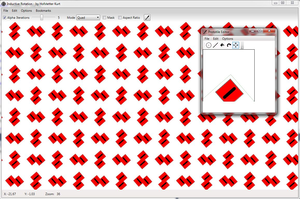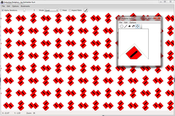Information
- Publication Type: Master Thesis
- Workgroup(s)/Project(s):
- Date: August 2015
- TU Wien Library:
- First Supervisor: Eduard Gröller
Abstract
The Inductive Rotation Method, developed by the artist Hofstetter Kurt, is a strategy for generating elaborate artistic patterns by applying translations and rotations repeatedly to a copy of a so called prototile. The method has been inspired by aperiodic tilings such as the popular Penrose tilings. The Inductive Rotation Patterns and their nonperiodic structure is interesting from both a mathematical and from an artistic point of view. In the scope of a previous thesis different algorithms for the generation of such patterns were already implemented and researched which resulted in a program called the “Irrational Image Generator”. However, this software prototype provides only few features which support Hofstetter in designing patterns, and can only produce patterns with limited size. The limited size results from a property of the patterns: The number of tiles grows exponentially with each iteration.The Inductive Rotation Framework, a software framework for the generation of Inductive Rotation Patterns, was developed in the course of this thesis and unites new generation algorithms with an extended tool-set, like a graphical prototile editor which supports Hofstetter in his pattern design process. One of the existing algorithms was successfully parallelized and now allows the artist pattern generation via GPGPU methods.
Depending on the implementation this can increase either pattern generation speed or the maximum pattern-size. In order to research the advantages and disadvantages of a recently developed tile substitution method for the creation of Inductive Rotation Patterns, the framework was extended by an algorithm which is based on this new discovery. Following the definition of the Inductive Rotation Method from Hofstetter, this tile-substitution method produces only a subset of Inductive Rotation Patterns.
By varying the definition of Hofstetter’s Inductive Rotation Method only slightly, the Sierpinski gasket, a fractal pattern, emerges. The similarity between the Inductive Rotation Method and fractals can be observed further by comparing the parallel generation algorithm’s matrix scheme to Iterated Function Systems (IFSs), which are used to generate fractals.
Additional Files and Images
Weblinks
No further information available.BibTeX
@mastersthesis{Sippl_Sebastian_EFG,
title = "A Framework for GPU-Assisted Generation and Composition of
Inductive Rotation Patterns",
author = "Sebastian Sippl",
year = "2015",
abstract = "The Inductive Rotation Method, developed by the artist
Hofstetter Kurt, is a strategy for generating elaborate
artistic patterns by applying translations and rotations
repeatedly to a copy of a so called prototile. The method
has been inspired by aperiodic tilings such as the popular
Penrose tilings. The Inductive Rotation Patterns and their
nonperiodic structure is interesting from both a
mathematical and from an artistic point of view. In the
scope of a previous thesis different algorithms for the
generation of such patterns were already implemented and
researched which resulted in a program called the
“Irrational Image Generator”. However, this software
prototype provides only few features which support
Hofstetter in designing patterns, and can only produce
patterns with limited size. The limited size results from a
property of the patterns: The number of tiles grows
exponentially with each iteration. The Inductive Rotation
Framework, a software framework for the generation of
Inductive Rotation Patterns, was developed in the course of
this thesis and unites new generation algorithms with an
extended tool-set, like a graphical prototile editor which
supports Hofstetter in his pattern design process. One of
the existing algorithms was successfully parallelized and
now allows the artist pattern generation via GPGPU methods.
Depending on the implementation this can increase either
pattern generation speed or the maximum pattern-size. In
order to research the advantages and disadvantages of a
recently developed tile substitution method for the creation
of Inductive Rotation Patterns, the framework was extended
by an algorithm which is based on this new discovery.
Following the definition of the Inductive Rotation Method
from Hofstetter, this tile-substitution method produces only
a subset of Inductive Rotation Patterns. By varying the
definition of Hofstetter’s Inductive Rotation Method only
slightly, the Sierpinski gasket, a fractal pattern, emerges.
The similarity between the Inductive Rotation Method and
fractals can be observed further by comparing the parallel
generation algorithm’s matrix scheme to Iterated Function
Systems (IFSs), which are used to generate fractals.",
month = aug,
address = "Favoritenstrasse 9-11/E193-02, A-1040 Vienna, Austria",
school = "Institute of Computer Graphics and Algorithms, Vienna
University of Technology ",
URL = "https://www.cg.tuwien.ac.at/research/publications/2015/Sippl_Sebastian_EFG/",
}

 Poster
Poster Thesis
Thesis


